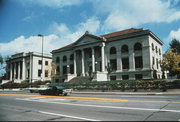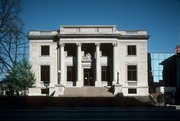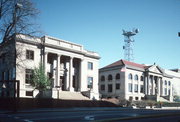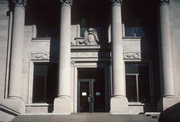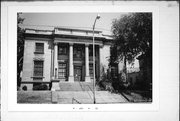Property Record
203 S FARWELL ST
Architecture and History Inventory
| Historic Name: | CITY HALL |
|---|---|
| Other Name: | City Hall |
| Contributing: | |
| Reference Number: | 29230 |
| Location (Address): | 203 S FARWELL ST |
|---|---|
| County: | Eau Claire |
| City: | Eau Claire |
| Township/Village: | |
| Unincorporated Community: | |
| Town: | |
| Range: | |
| Direction: | |
| Section: | |
| Quarter Section: | |
| Quarter/Quarter Section: |
| Year Built: | 1916 |
|---|---|
| Additions: | 1978 |
| Survey Date: | 1981 |
| Historic Use: | city/town/village hall/auditorium |
| Architectural Style: | Neoclassical/Beaux Arts |
| Structural System: | |
| Wall Material: | Limestone |
| Architect: | George Awsumb |
| Other Buildings On Site: | |
| Demolished?: | No |
| Demolished Date: |
| National/State Register Listing Name: | City Hall |
|---|---|
| National Register Listing Date: | 1/28/1983 |
| State Register Listing Date: | 1/1/1989 |
| National Register Multiple Property Name: |
| Additional Information: | A 'site file' exists for this property. It contains additional information such as correspondence, newspaper clippings, or historical information. It is a public record and may be viewed in person at the Wisconsin Historical Society, State Historic Preservation Office. Located just north of the former Eau Claire Public Library and attached to that structure by a glass-faced addition, the city hall is an imposing almost square structure rising two stories above a raised basement. The smooth ashlar walls are of buff Bedford limestone and the upper flight of entrance steps are fashioned from Carthage, Missouri marble. A shallow projecting pavilion supported by four colossal Corinthian columns resting on square stone pedestals highlights the facade. The main centrally-placed entrance is framed by pilasters and an entablature that includes the building's name. Above the name is a large sculptural feature resembling a cartouche. The windows on the first floor are large rectangular openings decorated with swags above and blind balustrades below. The upper story windows are smaller, simply framed openings. Originally all of the windows were multi-paned but they have been replaced by large plates of glass. Marking the top of the flat roofed structure is a pronounced cornice underscored by dentils. A parapet interrupted by balustrades continues above the cornice. In 1978-79 the interior of the building, which is ornamented with classical details, was altered as the neighboring library building was also being converted to city office use. Because of the alteration, the building's axial plan was obscured by the addition of desks and the permanent closing of the main entrance. The Eau Claire City Hall, designed by Chicago architect, George Awsumb, provides an architecturally significant example of Neo-Classical/Beaux ARts architecture. The two story stone structure, which complements its neighboring building, the Eau Claire Public Library, 217 S. Farwell Street, 1P/28, successfully integrates elements of the two architectural styles that dominated institutional design in the early twentieth century. Within the city, the equally significant variation of the style; however, it is not being nominated because it is federally owned. City Hall was designated an Eau Claire Landmark in 1976. George Awsumb, a former resident of Eau Claire, attended the University of Wisconsin and the University of Illinois from which he graduated in 1906. Awsumb practiced in Chicago where he was affiliated with the firms Jenny-Mundie and Jensen and later Marshall and Fox. He also taught design at the Chicago School of Architecture located in the Art Institute (B). In designing the Eau Claire City Hall Awsumb used the already existing Neo-Classical library as a guide. The city hall and library are architecturally related, employ the same construction material, and together use the raised site to its best advantage. Eau Claire's first city hall was erected after the city was incorporated in 1872. The two story brick structure stood on the northwest corner of Eau Claire and Farwell Streets and contained both city offices (on the second floor) and the fire station. This building was demolished in 1943. The new city hall was constructed in 1916 at a cost of $72,000 (C). 2016- "Eau Claire's first City Hall was erected soon after the City was incorporated in 1872. The two-story brick sturcture stood on the northwest corner of Eau Claire and Farwell streets and contained both city offices and the fire station. The present building was consturcted in 1916 at a cost of $72,000. It was designed by George Awsumb, a former Eau Claire resident. The architecutral style of the City Hall is typical of civic buildings of the early twentieth century. The almost square two-story structure is constructed of buff Bedford limestone. Highlighting the faceade is a shallow projecting pavilion supported by four Corinthian columns. Large plates of glass have replaced the original multi-paned windows. In 1978-79, the City Hall was attached to its neighbor, the former public library building." -"Eau Claire Landmarks: Designated Historic Properties in Eau Claire, Wisconsin", Eau Claire Landmarks Commission, P.O. Box 5148, 2016. |
|---|---|
| Bibliographic References: | (A) Building inscriptions. (B) The Municipality, February, 1916. (C) Barland, L. 1965. The Rivers Flow On, pp. 200, 253. (D) EAU CLAIRE LEADER-TELEGRAM 9/18/1994. Take a Walk on Main Street: Historic Walking Tours in Wisconsin's Main Street Communities, Wisconsin Main Street Program, 1998. Eau Claire Landmarks booklet published by the Landmarks Commission in 2002. |
| Wisconsin Architecture and History Inventory, State Historic Preservation Office, Wisconsin Historical Society, Madison, Wisconsin |

